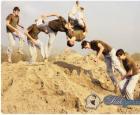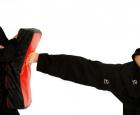Proper breathing during exercise. How to breathe correctly when doing exercises? Why exercises should be done while exhaling
Breathing during sports
High-quality enrichment of tissues with oxygen, according to doctors at the Reebok University in Dusseldorf (Germany), can slow down the aging process and help your body stay young and strong longer. You need to breathe deeply, inadequate, shallow breathing leads to the fact that the body is not saturated with oxygen, a person quickly gets tired and the fat burning process slows down.
When you hold your breath while lifting weights, your blood and intra-abdominal pressure increases. Holding your breath is not the only mistake; some people breathe too quickly or too slowly, or inhale and exhale at the wrong moment. Breathing too slowly can increase your heart rate, making you feel unwell.
Let's check the breathing method in practice. Place one hand on your chest and the other on your stomach. Which hand rises higher? With proper and deep breathing, this should be the hand that is on the stomach.
Proper breathing is also very important because the inhaled oxygen is very necessary for intense muscle work. Thus, you need to breathe so that your abdominal muscles contract, and breathing in which only the upper chest muscles rise is ineffective. By the way, full breathing is very important in everyday life, so remember this not only in the gym.
Let's look at the different types of training, starting in order.
Strength training in the gym.
Let's start with the fact that the mode of muscle work when performing exercises can be divided into overcoming and yielding. Everything is simple here: if, overcoming any resistance, the muscles contract and shorten, then such work is called overcoming. Muscles that resist any resistance can, when tense, lengthen, for example, when holding a very heavy load. In this case, their work is called inferior. In a specific example, the bench press will have an overcoming mode at the moment of squeezing the bar upward, and a yielding mode when lowering it to the chest. There is only one advice, we overcome - we exhale, we yield - we inhale. That is, at the moment of greatest muscle tension, we exhale, at the moment of easing the tension, inhale.
When you work with a trainer personally, you don't have to think about proper breathing. The trainer will teach you how to exhale and inhale at the right stage of the exercise and will constantly monitor proper breathing during your workout.
Breathing during aerobics. Especially in intensive lessons, some simply "forget to breathe." This leads to oxygen starvation, reduced intensity, dizziness. Sometimes the body perceives oxygen hunger as physiological; often after training you really want to eat. Inhale through the nose and exhale through the mouth. Why is it necessary to inhale through the nose? First, dust and microbes settle on the nasal mucosa. Secondly, when you inhale through your mouth, you experience a feeling of dryness in the oral mucosa, such discomfort leads to increased breathing. As a result, it turns out that there is not enough oxygen in the blood, which means that you do not achieve the main goal of the exercise - you do not burn fat, which, as is known, requires exposure to oxygen for oxidation. In fact, proper breathing during aerobics requires a sufficient level of training. Therefore, if you are a beginner, do not attend the most "advanced" and fastest classes. As long as you pay attention to your coordination and pace, your breathing will remain shallow, which means it is more effective for you to take a low or medium intensity class now.
Breathing while stretching.
Proper breathing during stretching helps the body relax, return to a state of rest and remove waste products from the body after an intense workout. Deep breathing also helps increase flexibility and stretch. As you exhale long, try to relax your muscles as much as possible and you will see how they become more pliable and softer. People who practice Pilates or yoga know how important breathing is in these classes.
Learn to breathe correctly, control your breathing, this will not only keep you healthy, but will also allow you to live much longer.
Usually we don’t think about how we breathe, we don’t track the depth and rhythm of our breathing. However, this is of great importance during strength training. Proper breathing allows you to increase the stabilization of the spine, normalize blood pressure and provide the muscles with enough oxygen.
So what's the right way to breathe? First, let's look at the breathing method itself, and later we'll talk about continuity and delays.
Diaphragmatic breathing
One of the mistakes that prevents you from practicing and getting excellent results is fast, shallow breathing.
To check if you are breathing correctly, do a short test. Stand up straight, place one palm on your chest and the other on your stomach, and calmly take a few breaths in and out. Under which palm do you feel the movement? If your stomach rises, you breathe deeply, using all your lungs; if your chest, you breathe shallowly. Deep breathing is also called.
The diaphragm is a muscle that separates the chest and abdominal cavities and serves to expand the lungs. It accounts for 60 to 80% of the work on ventilation of the lungs.
As a child, everyone breathes deeply. Due to sedentary work, stress, uncomfortable clothing, breathing changes with age and becomes shallow. During such breathing, only the upper part of the lungs is filled with air. Since there is less air flow, breathing becomes faster, increasing pressure on the neck and shoulders, which are already stressed in people with sedentary work.
The diaphragm, on the contrary, becomes weaker, which is why sufficient intra-abdominal pressure is not created, bad pressure is formed - the center of the abdomen falls inward, bringing the lower ribs and pelvis closer together.
In addition, when you breathe quickly and shallowly, you force your body to work harder to get the same amount of oxygen as when you breathe calmly and deeply. This reduces the efficiency of your movements - you spend more energy, although this is not required.
Therefore, it is worth working on breathing at least during the exercise. Try to breathe deeply and evenly. When inhaling, the stomach should inflate. Yes, you will have to concentrate more on your body, but for the sake of good posture, relieving tension in the muscles of the neck and shoulders, and more economical movement, it is worth doing.
To get ready for strength training with proper breathing, pay attention to how you breathe during the warm-up. Try to perform all exercises with rhythmic deep breathing. So you will quickly learn how to breathe correctly.
Exhale for effort, inhale for relaxation
This is the most popular breathing advice you hear in and out of the gym: inhale when you do the easy part of the exercise, exhale when you push it.
Strong and safe movement is only possible with a rigid spine, which transmits force from large muscle groups. The spine is strengthened by tensing the core muscles - the rectus and oblique abdominal muscles, the pelvic floor muscles, and the back. During inhalation, it is impossible to tense other core muscles well, which means it is difficult to provide the spine with the necessary rigidity.
When exhaling, on the contrary, it is quite simple to tighten the muscles of the core. Breathing affects them reflexively, through the nervous system. The muscles tighten, fixing the spine and helping to develop maximum strength. That is why the effort must be performed on the exhale.
If you pay attention to your breathing during heavy exercise, you may notice a brief cessation of breathing at the point of maximum effort. This is quite natural. Brief breath-holding is used by experienced powerlifters and weightlifters to lift heavy weights. This breathing technique is called the Valsalva maneuver, but it should be used very carefully.
Is the Valsalva maneuver dangerous?
The Valsalva maneuver is a procedure that creates high pressure in the middle ear, chest and abdominal cavities. It is used in otolaryngology to test the patency of the Eustachian tubes and in cardiology to identify heart pathologies. This maneuver is also used in powerlifting and weightlifting and helps athletes lift heavy weights.
The Valsalva maneuver used in strength sports is as follows: a person takes a deep breath (about 75% of the maximum possible), and then, at the moment of maximum effort, holds his breath for several seconds and tries to exhale air through a closed glottis. Breathing is held throughout the repetition, exhalation occurs after completion.
The Valsalva maneuver increases the pressure in the chest. Through the diaphragm, it is transmitted into the abdominal cavity, which creates good support for the back and helps resist forces that tend to move the spine. As a result, the athlete can lift more weight and the risk of injury is reduced.
Effects of the Valsalva maneuver on the body
However, the Valsalva maneuver is often criticized because it increases blood pressure that is already high during strength training, which can cause pain.
Opinions on this issue differ. Dr. Jonathon Sullivan, a professor in the Department of Emergency Medicine at Wayne State University, believes that only those who already have problems with the cardiovascular system should be wary of using the Valsalva maneuver.
In another study Effects of Weightlifting and Breathing Technique on Blood Pressure and Heart Rate . Using this technique to raise a one-time max has been found to cause only minor changes in blood pressure. The Valsalva maneuver is only suitable for lifting really heavy weights for low repetitions.
Using the Valsalva maneuver for multiple repetitions with light weights can cause dangerous increases in blood pressure, rupture of blood vessels in the eyes and face, headaches, temporary blurred vision, and may cause fainting or cerebrospinal fluid leaks.
The last problem was described in the article Don't Hold Your Breath. Vishal Goyal and Malathi Srinivasan, MDs, of the Department of Medicine at the University of California.
A 50-year-old patient complained of headaches in the projection of the nose, continuous cough and constant unilateral nasal discharge. As a result of the tests, doctors discovered a leak of cerebrospinal fluid and damage to the nasal ethmoid bone. It turned out that the patient performed chest presses every day with a weight of 90–136 kilograms. At the same time, he held his breath during the bench press.
Doctors suggested that the patient's problems arose precisely because of the Valsalva maneuver. The training increased blood pressure and destroyed the meninges, which caused meningocele and cerebrospinal fluid rhinorrhea.
The Valsalva maneuver does help lift heavy weights, but it should not be used if:
- you are a beginner who does not have a set technique and a trainer who can monitor the correct execution of the Valsalva maneuver;
- Do you prefer low weight, high rep exercises?
- you had problems with the cardiovascular system;
- you have had problems with intracranial pressure.
Strengthening the core and continuous breathing
For medium loads, it is worth using continuous breathing without delay - exhale for effort, inhale for relaxation.
Start exhaling a little earlier, a moment before maximum effort. This way you can do more.
Breathing should be smooth and rhythmic. Don't stop at the extremes. Immediately after inhalation, exhale without short delays.
To ensure maximum shell rigidity, try using the fastening method. This term was first used by Dr. Stuart McGill, a lumbar spine injury and rehabilitation specialist. Bracing is the activation of the entire core muscles to create a rigid midsection, provide core stability and reduce the risk of injury.
Before lifting weights, imagine that you are about to get hit in the stomach. Tighten your abdominal and back muscles. This will create a rigid corset that you need to hold throughout the entire exercise. At the same time, breathe continuously, exhaling with maximum effort and further strengthening your core.
There is another theory about breathing during... Dr. Stuart McGill and Dr. Mel Stiff believe that proper exercise technique will automatically force the body to breathe correctly, without any need for your supervision.
But this is only true for ideal technology. If you can't boast of one, work on your breathing as well as your technique.
Results
- Try to develop diaphragmatic breathing. Breathe like this during the warm-up to get used to and tune in.
- Use the Valsalva maneuver only for a few repetitions at maximum weight.
- For high-repetition exercises, use continuous, smooth breathing, inhaling for the easy part of the exercise and exhaling for the maximum effort.
- Along with continuous breathing, use bracing - tensing your core muscles to stabilize your core during exercise.
If you have any tips for breathing during strength training, please leave a comment.
Proper breathing will help you improve the effectiveness of your strength training and reduce the risk of injury. A few simple rules.
Want to maximize your performance and reduce the chance of injury? These five tips will help you safely lift more weight with maximum efficiency.
Unless you are a swimmer or freediver, you are unlikely to focus on your breathing. And when performing strength exercises, you most likely make unforgivable mistakes.
As people perform a rep, they either inhale and forcefully exhale, or they take in as much air as they physically can before lowering themselves to the bottom of a squat or lowering the barbell to their chest on a bench press.
But there is a much better way.
The thing is that breathing plays an important role not only during aerobic exercise, but also during anaerobic exercise.
It is important to remember that cardio exercises are different from strength exercises, so breathing should be different. Strength training requires more control.
Of course, breathing alone will not save you when performing squats with a barbell - technique is still needed here. Before focusing on breathing, you need to concentrate on the main features of the exercise - correct positioning of the legs, grip, location of the bar, amplitude, starting position, downward and upward movement. If you start with breathing, it will distract you, and you risk injury, since the technique of the exercise itself will be lame. Once you have mastered the automaticity of the movements that are the foundation of each exercise, proper breathing will come naturally. The main thing is to follow a few simple rules.
Here are some important tips to help you improve your breathing when doing strength exercises.
1. Take control of your breathing before exercising.

30 seconds before the approach, normalize your breathing. If it's too frequent, give yourself some more time. Calm down, relax your body, tune in to the approach. To saturate the muscles with oxygen, it is necessary to slow down the heart rate. Some try to trigger their nervous system with sharp and rapid breathing - as if they are preparing to set a dislocated shoulder.
If you deplete your oxygen supply and get your heart racing before lifting a lot of weight, you won't reach your full potential in the exercise.
Before the approach, this type of breathing is unproductive.
Useful article: The right set of muscle mass - 10 common mistakes
2. Any exercise consists of two phases: eccentric and concentric. In the first phase, the muscles are stretched, and in the second phase they are contracted.
As an example, consider the barbell squat. To practice breathing technique, just use an empty bar. After you have mastered your breathing, you can begin warming up and then working weights.
Take the bar and take the starting position. Before starting the eccentric phase, take a gentle breath in and out to fill your body with oxygen. Avoid taking too sharp or strong breaths.
Inhale and, holding your breath, begin to lower yourself down to the bottom point. Returning to the starting position, exhale during the most difficult phase of the lift.
Many athletes make the big mistake of exhaling too early. Meanwhile, early exhalation not only depletes your reserve of strength, but also has a negative effect on the spine and lower back, because after exhalation you can no longer maintain the necessary intramuscular tension. Consequently, the load will fall on the spine and lower back, which are very easy to injure.
Imagine holding your breath underwater: there you will only be able to inhale when you reach the surface and emerge. In our case, the water surface is the moment when you come out of the heaviest phase of the squat.
3. Change Your Breathing Technique When Performing Deadlifts.
The deadlift has a different nature of movement, and therefore requires a different approach.
You will immediately feel tension as soon as you begin to lift the barbell off the floor. Therefore, before starting the concentric part of the movement, concentrate, tense your whole body, slightly pulling the barbell towards you, take a breath and, holding your breath, begin to lift the barbell up. After finishing the concentric phase, begin to exhale as you lower the barbell.
Useful article:
4. If you think that during strength training you need to inhale deeply and exhale sharply, you are mistaken. Don't imagine that you are blowing out the candles on a cake. You're not at a birthday party, but at a training session!
Do not swallow air, but take short breaths and exhales.
Taking large breaths reduces your intramuscular tension, which can increase your chance of injury.
5.If you feel like you need more air, breathe in the eccentric phase.
There's nothing wrong with wanting to take an extra breath when performing a high-repetition set. Just don’t inhale in the concentric phase; it’s better to take the desired portion of air in the eccentric phase.
By using these simple tips, you will improve your performance in training and reduce the risk of injury.
Gettyimages/Fotobank.ru
I remember my first day at the fitness club very well. I was terribly worried, confused in my movements on the steppe, lost pace during strength training and was constantly puffing like a steam locomotive. Then I thought that I couldn’t catch my breath due to nerves, lack of experience and excess weight. However, six months later, when experience seemed to have arrived and the kilograms began to fall off, I was still out of breath during training. Then I began to figure out how to breathe correctly. Are there any subtleties and secrets that allow you to endure a long run, class or workout in the pool without stress? Here's what I learned about it from the coaches.
Breathing during cardio
After reading about running on the Internet, you will inevitably doubt it. “You need to take a breath for every third step,” says one website. And on the other: "Inhale and exhale for two counts." Some people claim that light, shallow breathing helps you endure a run, while others say that deep and even breathing helps you endure a run.
“And all because the breathing patterns of runners can be different,” says Alexander Chapaikin, master trainer of the World Class network of fitness clubs. - Do not, imitating someone, try to breathe in a strictly defined step. Sprinters breathe quickly and shallowly. But if you have to walk a kilometer or more, your breathing should be deep and full. Frequently? Slow down and try to keep the speed a little lower than the speed at which this happened.” Place the emphasis on a full exhalation: it will certainly be followed by an equally full inhalation. Professional athletes take several deep breaths before starting (regardless of the distance).
As for other types, here, alas, there are no special techniques that would help you withstand the training. There is only one piece of advice here. “Breathe in a way that is comfortable for you,” says Ignat Klyatsky, manager of the gym at the Zebra fitness club on Avtozavodskaya. - Did you start to choke? Most likely, the selected workout turned out to be too difficult for you and will have to be interrupted.”
To determine whether or not you can continue the activity, measure your pulse if possible. The fact that it is close to the maximum (calculated using the formula 220 minus age) is an alarming sign. If you are a young, experienced athlete and, although you are breathing heavily, overall you feel good, you can continue training. If you have already passed forty and you have not done fitness for a long time, if you have problems with blood pressure and you experience dizziness, tightness in the chest, nausea - take a break and rest: walk calmly, raising your arms as you inhale and lowering them as you exhale.
How to breathe properly during strength training
The main rule is to make an effort on exhalation. Firstly, on inhalation and additional load on the body is useless. And secondly, it is much easier to concentrate. Beginners are advised to blow the air out of themselves with a noisy “wow!” so as not to hold their breath. Just don't overdo it. Rattling and growling will sound more comical than courageous.
“But for experienced athletes who have been involved in fitness for more than 5-7 years, it is sometimes permissible to bypass these rules,” says Ignat Klyatsky. — Difficult coordination movements are performed literally with bated breath. Take, for example, the plank exercise. If, while performing it, you place your toes not on the floor, but on a small ball, then it will be very difficult to maintain your balance. And they remain in this position for only 10-15 seconds - if you don’t breathe during this time, there will be no trouble. If the exercise, on the contrary, is quite simple (raises or raises), and you do it on a machine and with little resistance, you can breathe comfortably. But when you take a lot of weight, when you perform an exercise in which the chest is compressed at least a little while exhaling (for example, a close-grip barbell press from the chest from a lying position), the effort is only on the exhale. No matter how much experience you have in fitness.”
If you did a breath-holding exercise, be sure to “breathe” after it: pedal for a couple of minutes at a speed of 10 km/h, walk without complex programs, just at a good, fairly fast pace.
Swimming
The most difficult thing is to learn to exhale into the water. At first it is so unpleasant that you start to panic. And instead of vigorously blowing bubbles with your mouth and nose, as the instructor advises, you hold your breath completely. Why suffer so much if you can keep your head above water all the time?
“Firstly, in this case you won’t swim far,” says Yulia Verbina, master of sports in swimming, personal trainer of the Marina Club aquatic programs. — You will start to get tired literally after 20-30 meters. And secondly, such training can be harmful: the back muscles will be in constant tension. Master the correct technique and you will be able to breathe deeply and evenly, no matter what style, what distance or how fast you go.”
Take a short and powerful breath through the mouth: at one count we completely fill the lungs with air. Exhale for a long time, through the mouth and nose: this helps to get rid of the water that has entered the nostrils. In breaststroke, a breath must be taken on every stroke, in butterfly - perhaps on every second stroke, in front crawl - on the second, third, fifth or seventh, all the time under one hand or alternately under the right and left. And only by floating on your back can you breathe as you like, preferably in the same rhythm and without delay.
Training yourself to breathe properly during exercise can be difficult. Perhaps at first you will be confused and angry that this is only bothering you. But then you will definitely understand that all your efforts were not in vain. When you complete your first kilometer jogging or in the pool without rest.
To breathe or not to breathe, to inhale or exhale, how long should the inhalation be and how short should the exhalation be? Many people just starting out in fitness (and even quite experienced “fitnessists”) ask this question. At school, in physical education classes, we were taught one thing, now in classes at the fitness club we learn something completely different... How is this correct?
Breathing is such a natural process for us that most often we don’t even notice how we breathe. But once you cut off the oxygen, life slows down. Breathing plays an equally important role during training: after all, if you learn to control your breathing, you can significantly lighten the load on the cardiovascular and respiratory systems and increase the effectiveness of the training process.
It turns out that breathing depends on what exercise we perform.
Flexibility exercises
These are exercises that, as a rule, trainees include in their warm-up - bends, turns, rotation of the torso, swing, circular movements of the arms and legs. In these exercises, you inhale in positions that promote expansion of the chest, and exhale when it contracts. For example, when bending forward, touching the floor with your hands, you should inhale in a position where the torso is straightened, arms are lowered and slightly pulled back. It has been experimentally proven that this is the position that helps fill the lungs with air to the greatest extent. And you need to exhale while bending forward: the chest and abdominal organs are compressed at this moment, which helps to more completely displace the air.
Strength exercises
In these exercises, everything depends on muscle tension - it is recommended to exhale at the moment of greatest muscle effort, and inhale at the moment of the least. That is, if you raise your legs up from a position lying on your back, then inhale while raising your legs, and exhale while lowering them down, when the tension in the abdominal muscles is greater. When doing push-ups from the floor in a lying position, inhale while bending your arms, and exhale while straightening.
The main rule in this case is not to hold your breath! Holding your breath - especially during the most intense stage of the exercise (for example, deadlifts, bench presses, etc.) can cause a short-term loss of consciousness due to oxygen starvation of the brain. In addition, holding your breath can significantly increase your blood pressure. So breathe freely!
Cyclic exercises
During these exercises (walking, running, cycling, swimming, etc.), it is especially important to breathe correctly, because the body's need for oxygen increases several times.
When running, first of all, you need a rhythm and frequency of breathing that is coordinated with the movements of the body. Erratic breathing, with pauses or, on the contrary, too rapid breathing disrupts the rhythm of running, complicates coordination and does not provide sufficient ventilation of the lungs. For example, when running slowly, each inhalation and exhalation takes 3–4 steps, and when moving at an average speed, each inhalation and exhalation takes 1–2 steps.
The nature of breathing is completely different when running quickly over short distances. Here the need for oxygen is so great that the most perfect breathing cannot satisfy it. In this case, the body, as physiologists say, “works on debt.”
The breathing is dictated by the style. If you are swimming breaststroke, you can only inhale when you lift your head above the water; if crawl, then at the end of the stroke, when the face is turned to the side and the mouth is above the water. During other phases of swimming, you can only exhale air into the water.
When performing cyclic movements, try to breathe evenly and deeply, focusing on exhalation. The more fully you exhale, the deeper the inhalation and the better the ventilation of the lungs. However, a sense of proportion is necessary in everything. Excessively deep breathing can have the opposite effect.
Studies have shown that under moderate load it is advisable to breathe so that the tidal volume is 25-40% of the vital capacity of the lungs, and under heavy load - 40-70%. Of course, it is impossible to independently determine the tidal volume with an accuracy of one percent, but with desire and persistence it is possible to get closer to the required values. The reference point will be the amplitude of movements of the chest. Inhale and exhale as completely as possible and notice how much your chest expands. With a moderate load, it is advisable to breathe so that it expands by one third of the maximum, and with a heavy load - by two thirds.
Also, when doing physical exercise, try to breathe through your nose. This condition is especially important if training takes place outside. The outside air, passing through the nasal passages, heats up and is cleared of dust and microorganisms. When we breathe through our mouths, air immediately enters the nasopharynx, dust and germs partially settle on the tonsils, and partially penetrate the trachea and bronchi. Pollution and hypothermia of the respiratory tract often cause colds and infectious diseases.







 The best exercises to improve your metabolism Metabolic training for weight loss
The best exercises to improve your metabolism Metabolic training for weight loss Jumping rope: benefits for weight loss Why is jumping rope beneficial?
Jumping rope: benefits for weight loss Why is jumping rope beneficial? Mastering the technique of doing somersaults How to learn how to do somersaults at home
Mastering the technique of doing somersaults How to learn how to do somersaults at home The hardest punch in boxing?
The hardest punch in boxing?